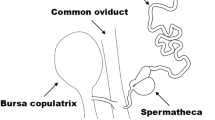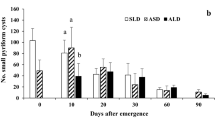Abstract
The role of apyrene sperm in monandrous species after sperm migration to the spermatheca has not been studied, though in polyandrous species these sperm reduce re-mating receptivity. We studied the relationship between apyrene sperm numbers and age, mating history, and fecundity in females of the monandrous pipevine swallowtail butterfly, Battus philenor (L.) that were collected in the desert of central Arizona. The number of spermatophores in the bursa copulatrix and the eggs in the ovaries were counted and their relationship to female age (as indicated by wing wear) was examined. The mean number of spermatophores in the oldest females was 1.4, confirming that this species is monandrous. Average female fecundity was estimated at 430 from counts of eggs in the ovaries. Recently mated females stored many more eupyrene sperm in the spermatheca than the number of eggs in the ovaries. Apyrene sperm were also found in the spermatheca of the females with a long period elapsed after the mating, as indicated by a collapsed spermatophore. The potential role of apyrene sperm and the effect of body size on the fecundity in monandrous species is mentioned.



Similar content being viewed by others
Reference
Arnqvist G, Rowe L (2005) Sexual conflict. Princeton University Press, Princeton
Arnqvist G, Edvardsson M, Friberg U, Nilsson T (2000) Sexual conflict promotes speciation in insects. P Nat Acad Sci USA 97:10460–10464
Baer B, Eubel H, Taylor NL, O’Toole N, Millar AH (2009) Insights into female sperm storage from the spermathecal fluid proteome of the honeybee Apis mellifera. Genome Biol 10:R67
Bissoondath CJ, Wiklund C (1995) Protein content of spermatophore in relation to monandry/polyandry in butterflies. Behav Ecol Sociobiol 37:365–371
Boggs CL (1995) Male nuptial gifts: phenotypic consequences and evolutionary implications. In: Leather SR, Hardie J (eds) Insect reproduction. CRC Press, New York, pp 215–242
Boggs CL, Gilbert LE (1979) Male contribution to egg production in butterflies: evidence for transfer of nutrients at mating. Science 206:83–84
Boggs CL, Watt WB (1981) Population structure of pierid butterflies IV. Genetic and physiological investment in offspring by male Colias. Oecologia 50:320–324
Cook PA, Wedell N (1999) Non-fertile sperm delay female remating. Nature 397:486
Curril IM, LaMunyon CW (2006) Sperm storage and arrangement within females of the arctiid moth Utetheisa ornatrix. J Insect Physiol 52:1182–1188
Dunlap-Pianka H, Boggs CL, Gilbert LE (1977) Ovarian dynamics in heliconiine butterflies: programmed senescence versus eternal youth. Science 197:487–490
He Y, Tanaka T, Miyata T (1995) Eupyrene and apyrene sperm and their numerical fluctuations inside the female reproductive tract of the armyworm, Pseudaletia separata. J Insect Physiol 41:689–694
Holt GG, North DT (1970) Effects of gamma irradiation on the mechanisms of sperm transfer in Trichoplusia ni. J Insect Physiol 16:2211–2222
Kawagoe T, Suzuki N, Matsumoto K (2001) Multiple mating reduces longevity of females of the windmill butterfly Atrophaneura alcinous. Ecol Entomol 26:258–262
Konagaya T, Watanabe M (2015) Adaptive significance of the mating of autumn-morph females with non-overwintering summer-morph males in the Japanese common grass yellow, Eurema mandarina (Lepidoptera: Pieridae). Appl Entomol Zool 50:41–47
LaMunyon CW (1997) Increased fecundity, as a function of multiple mating, in an arctiid moth, Utetheisa ornatrix. Ecol Entomol 22:69–73
LaMunyon CW (2000) Sperm storage by females of the polyandrous noctuid moth Heliothis virescens. Anim Behav 59:395–402
Oberhauser K, Frey D (1999) Coercive mating by overwintering male monarch butterflies. In: Hoth J, Merino L, Oberhauser K, Pisanty I, Price S, Wilkinson T (eds) 1997 North American conference on the monarch butterfly. Commission for Environmental Cooperation, Montreal, Canada, pp 67–78
Odendaal FJ (1989) Mature egg number influences the behavior of female Battus philenor butterflies. J Insect Behav 2:15–25
Pegram KV, Han HA, Rutowski RL (2012) Overnight perching aggregations of the aposematic pipevine swallowtail (Battus philenor: Lepidoptera: Papilionidae): implications for predation risk and warning signal use. J Res Lepidoptera 45:9–16
R Core Team (2013) R: a language and environment for statistical computing. R Foundation for Statistical Computing, Vienna
Roth S, Reinhardt K (2003) Facultative sperm storage in response to nutritional status in a female insect. P Roy Soc Lond B Biol 270:S54–S56
Rutowski RL, Alcock J, Carey M (1989) Hilltopping in the pipevine swallowtail butterfly (Battus philenor). Ethology 82:244–254
Silberglied RE, Shepherd JG, Dickinson JL (1984) Eunuchs: the role of apyrene sperm in Lepidoptera? Am Nat 123:255–265
Svärd L, Wiklund C (1991) The effect of ejaculate mass on female reproductive output in the European swallowtail butterfly, Papilio machaon (L.) (Lepidoptera: Papilionidae). J Insect Behav 4:33–41
Tatar M (1991) Clutch size in the swallowtail butterfly, Battus philenor: the role of host quality and egg load within and among seasonal flights in California. Behav Ecol Sociobiol 28:337–344
Vande Velde L, Damiens D, Van Dyck H (2011) Spermatophore and sperm allocation in males of the monandrous butterfly Pararge aegeria: the female’s perspective. Ethology 117:645–654
Watanabe M (1988) Multiple matings increase the fecundity of the yellow swallowtail butterfly, Papilio xuthus L., in summer generations. J Insect Behav 1:17–29
Watanabe M, Ando S (1993) Influence of mating frequency on lifetime fecundity in wild females of the small white Pieris rapae (Lepidoptera, Pieridae). Jpn J Entomol 61:691–696
Watanabe M, Hachisuka A (2005) Dynamics of eupyrene and apyrene sperm storage in ovipositing females of the swallowtail butterfly Papilio xuthus (Lepidoptera: Papilionidae). Entomol Sci 8:65–71
Watanabe M, Nishimura M (2001) Reproductive output and egg maturation in relation to mate-avoidance in monandrous females of the small copper, Lycaena phlaeas (Lycaenidae). J Lepid Soc 54:83–87
Watanabe M, Nozato K (1986) Fecundity of the yellow swallowtail butterflies, Papilio xuthus and P. machaon hippocrates, in a wild environment. Zool Sci 3:509–516
Watanabe M, Sato K (1993) A spermatophore structured in the bursa copulatrix of the small white Pieris rapae (Lepidoptera, Pieridae) during copulation, and its sugar content. J Res Lepidoptera 32:26–36
Watanabe M, Bon’no M, Hachisuka A (2000) Eupyrene sperm migrates to spermatheca after apyrene sperm in the swallowtail butterfly, Papilio xuthus L. (Lepidoptera: Papilionidae). J Ethol 18:91–99
Wedell N (2005) Female receptivity in butterflies and moths. J Exp Biol 208:3433–3440
Wiklund C, Kaitala A, Lindfors V, Abenius J (1993) Polyandry and its effect on female reproduction in the green-veined white butterfly (Pieris napi L.). Behav Ecol Sociobiol 33:25–33
Willers JL, Schneider JC, Ramaswamy SB (1987) Fecundity, longevity and caloric patterns in female Heliothis virescens: changes with age due to flight and supplemental carbohydrate. J Insect Physiol 33:803–808
Yan S, Li H, Zhang J, Zhu J, Zhang Q, Liu X (2013) Sperm storage and sperm competition in the Helicoverpa armigera (Lepidoptera: Noctuidae). J Econ Entomol 106:708–715
Acknowledgments
We thank Dr. T. Yokoi, University of Tsukuba for valuable comments. This work was supported in part by JSPS KAKENHI Grant Number 24570019 (MW).
Author information
Authors and Affiliations
Corresponding author
Rights and permissions
About this article
Cite this article
Konagaya, T., Mutoh, N., Suzuki, M. et al. Estimates of female lifetime fecundity and changes in the number and types of sperm stored with age and time since mating in the monandrous swallowtail butterfly, Battus philenor (Lepidoptera: Papilionidae) in the Arizona desert. Appl Entomol Zool 50, 311–316 (2015). https://doi.org/10.1007/s13355-015-0336-9
Received:
Accepted:
Published:
Issue Date:
DOI: https://doi.org/10.1007/s13355-015-0336-9




